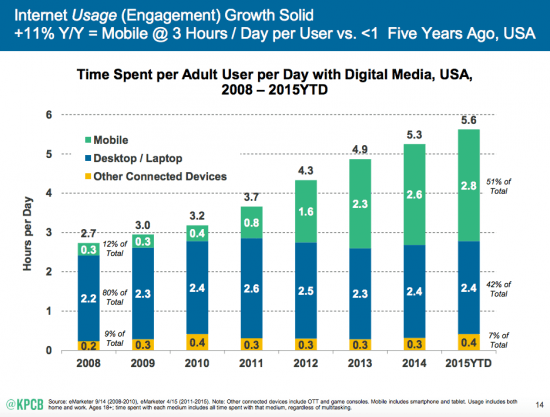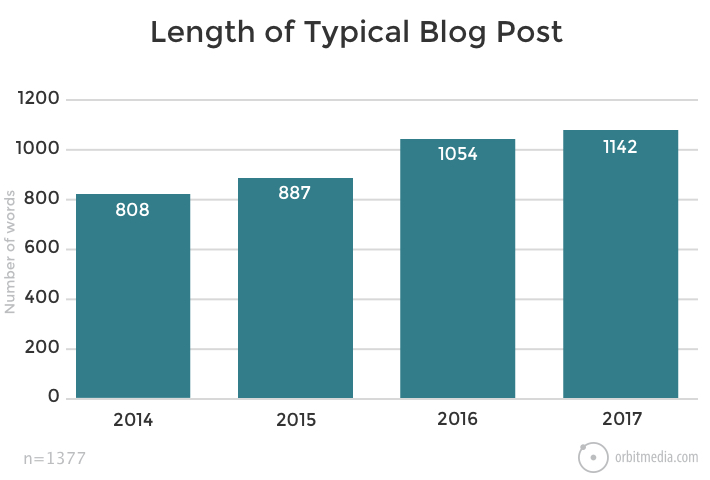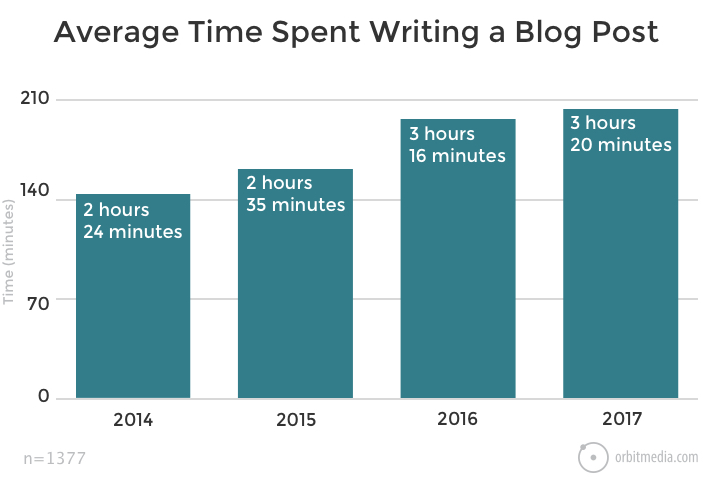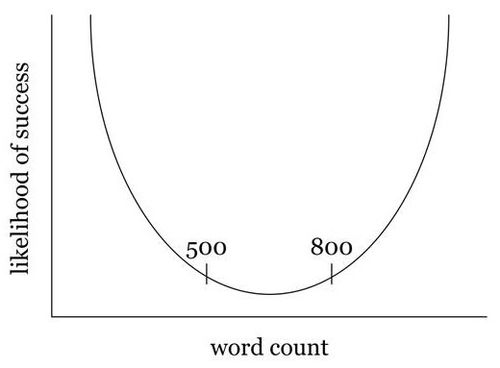- Blog Home
- Content Marketing
- Mark T
- Taking The Long View On Long Form Content
Taking the Long View on Long-Form Content

Are you sitting comfortably? How much time can you set aside to read a long-form, data-heavy investigation into a complex topic? For a growing number of online readers, the answer is: "I have as much time as it takes to understand the issue."
Long-form blogs (more than 1,000 words) are more in-demand than they have ever been, based on data and surveys covering the habits of bloggers and their readers in 2017.
But why? It seems a bit odd because so many articles in the media seem to be saying that attention spans are shrinking and people just want to watch simple videos. It's certainly true that the public must navigate more websites and more distractions from gadgets than ever before. Globally, people are reporting feelings of increased pressure to work more and sleep less to keep up with it all.
In our new multi-platform world, where Americans are spending around 51 percent of their time online staring at their smartphones, it makes more sense that video would be the default. Who wants to scroll through thousands of words on a five-inch screen? Then again, who would want to watch a TV show on their phone with the giant flat-screen TV in the next room?
[Source]
Due to the growth of mobile traffic, several large sites have made the pivot to video, even though they have met with limited success. As mentioned in our video pivot blog, a VP at Facebook even suggested that their entire platform could be 100 percent video within five years.
So, what is really going on? Is writing fading into history as we enter the Age of Video or are we witnessing the rebirth of long-form storytelling?
To solve a mystery as subtle and complex as this one, we could use a bit of advice from the world's first and best detective, Sherlock Holmes:
"'Data! Data! Data!' he cried impatiently. 'I can't make bricks without clay.'"
Data it is, then.
Longer Blogs, Stronger Returns
Orbit Media's 4th Annual Blogger Survey is a treasure trove of data and visualizations on how blogging practices have changed since 2014. One of their key findings was that the average blog length has expanded up to 1,142 words today, up from 808 in 2014.
[Source]
Although long-form blogs of 1,500+ words represent only 19.3 percent of the total number of blogs in the survey, this category has been growing rapidly as shorter blogs dwindle away. The largest jump has been the category of blogs coming in over 2,000 words, which is now used by six times as many bloggers as three years ago. The sharpest decline has been in the category of blogs 500 words or fewer, which dropped from more than 20 percent of blogs in 2010 to less than 10 percent now.
[Source]
There has been a corresponding rise in the number of hours spent writing the average blog. The average is now three hours and 20 minutes, up from two hours and 24 minutes in 2014. When you break down that average, however, you see that more than a quarter of writers (27.16 percent) are spending more than four hours per blog. Half of that group is spending more than six hours per blog. That kind of commitment is unsustainable unless longer blogs make good on their resource commitments. It also suggests that groups of bloggers with distributed responsibilities can be more successful than the legendary lone bloggers of the web's wild past.
[Source]
What Happened to Short Blogs?
One conjecture is that social networks have taken the place of short blogs. They may be smarter platforms for the rapid spread of brief but timely observations. However, long-form blogs perform better as evergreen sources of vital information, requiring greater detail and more carefully constructed arguments.
Bloggers who reported "strong results" from their efforts are the loquacious ones. Over 56 percent of bloggers say 2,000+ word articles deliver results, while only 20 percent say the same for blogs of 1,000 words or fewer.
[Source]
Orbit Media cautioned that this data does not mean that long form is always better. More time and more resources devoted to the blog does correlate positively with higher ROI, though, and that usually results in a longer blog. They concluded performance comes from "going deep into the subject matter, answering questions from every angle, and making a sincere effort at producing the best page for the topic." That can often take more than 1,000 words and there really is no upper limit.
Why Do Longer Blogs Perform Better?
Do long blogs just appear to have better metrics? Could it be that readers are spending longer on the page because people are scrolling, not because they are really interested? Although time on the page is often equated with engagement, there's much more evidence that longer blogs can deliver better results more consistently.
The Content Marketing Institute reported that content marketing crossed an important milestone this year.
In 2017, 52 percent of B2B and 51 percent of B2C marketers considered blogging to be their most critical tactic for achieving success in the year ahead.
At the same time, as blogs get longer, the stakes tend to get higher. People tend to be less judgmental over short blogs, which can only touch on issues or spark commentary. On the other hand, when the writer seeks to monopolize the reader's time and attention with a long-form blog, the reader is able to evaluate their arguments more closely and judge flaws more harshly.
As businesses seek out ways to achieve more with each blog and readers select blogs based on higher value, blogs have had to cover more ground.
Arguing for the benefits of 3,000+ word blogs, KISSMetrics and CrazyEgg founder Neil Patel stated unequivocally, "Longer posts usually perform better on every level." Patel pointed to his own results with 4,000+ word blogs that brought in 100,000 visitors the first year. In terms of hard data, his research uncovered that:
- Blogs in the 3,000 to 10,000 word count range brought back an average 11.07 links, compared to under 1,000 word blogs, which averaged just 3.47 backlinks. (BuzzSumo + Moz)
- Blogs of 2,500+ words generated nearly two times the social shares of shorter blogs. Also, blogs in the 2,250 to 2,500 range dominate the average organic traffic of all other blog lengths. (HubSpot)
- Long-form content converted at a rate 30 percent higher than short form. (CrazyEgg)
- An analysis of the top 10 search results over 20,000 keywords found that the five highest ranking blogs averaged a word count of 2,070 words, followed by an average of 1,471 words for blogs ranking in six to 10 slots. (CoSchedule)
That's only half of the story, though.
Are Attention Spans Getting Shorter?
While the online world is bubbling with distractions, one popular myth that has been debunked is that the human attention has become shorter than that of a goldfish. It's not that people can't pay attention anymore, it's that they are getting smarter about avoiding time-wasting click-bait.
Uberflip compiled data showing that people are skimming more and reading less, at least until they find what they want. Heatmaps of eye movements show that readers tend to look at blogs in an F-pattern, with the majority of their attention going to the headline and then at the headers down the left-hand side of the story. Around 55 percent of pageviews are capturing the reader's attention for 15 seconds or less.
[Source]
They concluded that it is a waste of resources to write posts just to fulfill daily or weekly quotas. If your post won't come across strong enough to move you closer to your goal, it could be driving away your potential fans. Too many readers "are consistently being thrown into poor content experiences that are not helping them."
When Are Shorter Blogs Better?
The biggest roadblock to creating effective long-form content is the amount of time, energy and research it demands. In a crunch for resources, many businesses end up publishing filler, or zombie content, that has been spun or glossed from other long-dead blogs.
Not every blog can or should be a long one. Short blogs have their uses, and top sites match the length of the blog to the effect they want to create. If there is a topic your customers and prospects really want to understand better, share what you know in a long blog. If you have a short, punchy infographic or video that really stands out from a sea of sameness, share that instead.
Marketing guru Seth Godin has been successful with blogs as short as 57 words. The image-heavy IFL Science found that their shortest blogs are the ones that get shared the most. Their posts are thought-provoking, counter-intuitive and educational. But they are not the kind of informational pieces that can be repurposed along multiple channels and continue to bring in backlinks over the long run.
Rob Marsh at CopyHackers suggested that there are five characteristics shared by successful blogs that run in the 500 words or fewer category:
- A large established fan base - When you have 21 million followers on Facebook, as IFL Science does, you can afford to be brief. They still struggle to post the kind of stories that their fans are likely to enjoy and share, but they can count on comments from brand advocates to add value. If you are not there yet, work on building your fan base with long-form content. Then ramp up engagement strategies to get them talking to each other.
- Remarkable, counter-intuitive stories - Surprise is the heart of storytelling. You can tell a story in just a few words as long as they contain a surprise. The shorter the content, the less room there is for SEO to buoy its ranking. Only observations that astonish the reader can break through. This is another area where the authority of the top domain becomes a part of the story.
- Arresting images - One great video, infographic or photo could be worth a thousand words or more. Short blogs, some as short as a few sentences, are appropriate. You are best off not diluting the power of the image unless the comments add essential context. Images that can't carry a story on their own are still valuable in making a long-form blog more engaging.
- Short lifetimes - One of the secrets of Godin's short blogs is that he has posted every day for over 14 days. In the past, he has written 15 blogs in a day and then scheduled them out for two weeks so he can replace them with better ones as he continues to write. He's had to give up a great deal to get there, such as television, meetings, Twitter and answering comments. Top short post sites like IFL Science posts blogs several times a day. Short posts can't survive without a lot of company.
- Concentration - Posts of 500 words or fewer do well when they focus on a single, share-worthy idea. This is not a useful format for discussing complex concepts, curating a series of links, or walking the reader through a process. Keep it simple and promote it heavily on social. Some bloggers have had success collecting their shorter blogs to create a long-form ebook or online course.
Writing on the Curve
An interesting point made by Patel is that BuzzFeed straddles both worlds - alternating between short but fun blogs built around dramatic images/video and the long-form investigative-style articles like the Wait But Why series, which runs 1,500+ words.
This is the same strategy described by The Quartz Curve. Quartz Editor-in-Chief Kevin Delaney wrote, "The place between 500 and 800 words is the place you don't want to be because it's not short and fast and focused and shareable, but it's not long enough to be a real payoff for readers."
[Source]
The same applies to their videos, which are broken into quick news bits and long documentaries. In fact, the comparison to a documentary is a good way to think about long-form content. People who are willing to watch a documentary are strongly motivated to understand the subject. They want answers and suggestions on how to dig deeper.
What they definitely don't want is a collection of facts that can be easily gathered by clicking around the web. As consumers, they still want entertainment, gossip, opinions and other forms of simplistic content but that's not all they want. When a topic really matters to them, their families or their careers, readers have a need for hard data, rational arguments, balanced investigations and lived experience.
Those are things that seem always to be in the highest demand and shortest supply online. Businesses that build up a library of instructional, informative articles have gained an army of devoted brand advocates. That's exactly what has happened with long-form content deployed on sites such as Blog Tyrant and Moz.
We are still in the process of transitioning from a service economy to a knowledge economy. Yet, in some areas, knowledge has already adopted many of the characteristics of currency. Data can be bought and sold on data exchange marketplaces, niche industries have been built around information brokers, and knowledge is regularly converted into cash in the freelance economy.
The value of long-form content can only appreciate under those conditions as people seek deeper insights and a fuller awareness of the issues that affect them. They will use long-form content as a window into what is most likely to happen next. There's little room in that future for shallow blogs and zombie content.
Net Neutrality and the Consolidation of Voices
In the near future, the blogosphere is likely to look very different due to media consolidation. First of all, the FCC just ended the decades-old media cross-ownership ban. That means a single company is now free to own all the newspapers, television channels and radio stations in small markets.
The FCC's reasoning was that the web now provides the diversity of thought and opinion that old world media used to protect. Many larger firms have been waiting for this moment so you can expect to see a wave of greater consolidation in the media as the drive for greater efficiencies of scale makes its way into smaller markets.
At the same time, the agency has made the first moves to end net neutrality by 2018. This is a highly controversial topic that has sparked intense emotional arguments and social media has only served to polarize opinions.
The essential issue, as summed up by Fortune magazine, is that "The elimination of net neutrality means that internet providers can carve up service into fast and slow lanes, charging more for higher speeds.... If content companies don't want to pay, internet service providers could make them so slow that they're unwatchable or even block access to competitors' sites."
Surprisingly, this is one of the few current issues where politics do not correlate to values. A survey by Mozilla found that 73 percent of Republicans and 81 percent of Democrats are in favor of net neutrality. Even the ultra-conservative site Newsmax announced that "Trump voters support net neutrality protections by a three-to-one margin."
It might even be true that those most in favor of repealing net neutrality are algorithms. One analysis of pro-repeal comments using natural language processing techniques concluded that at least 1.3 million of them came from bots, while 99 percent of comments in favor of keeping net neutrality were written by humans.
Whether net neutrality is abolished next year or kept in place through legal challenges, the consolidation of media sources is moving ahead full steam.
A couple of good examples include the AT&T/Time Warner merger, which will certainly happen in some as-yet-unidentified form, and the Time magazine group - spun off from their parent in 2014 - which is scheduled to be swallowed up by the mega-publisher Meredith.
In a future of fewer online voices, long-form content - with its ability to look deeper into topics, engage readers with storytelling techniques and promote awareness instead of simplistic catchphrases - is likely to become a blogger's most valuable communication channel.
Powered by Scripted.com
Published by Mark T on Wednesday, December 13, 2017 in Content Marketing, Content Writers, Content Writing Seo, Long Form Content.




